Cellular Mobile Communication System -3.Location Registration
Under a cellular mobile communications system, connections cannot be automatically made unless the network side always identifies where the mobile unit is located as the unit itself is continuously moving in space -- unlike the situation with a fixed telephone. The process that carries out this essential function is known as location registration.
Location information is registered in the network via signals from the cell station to the mobile unit. When a location change is subsequently detected, the mobile unit updates its internal location registration and notifies the network. When the mobile unit is turned on, the mobile unit uses signals from the cell station to compare the location information stored within its internal memory, and notifies the network of the new registration location if it detects any difference.
While location registration in cellular mobile communications systems is generally carried out by multiple-cell registration area units, frequent location registration switchovers can occur around cell boundaries due to fluctuations in reception levels. Overlay location registration is a method to establish an individual area for each mobile unit using the mobile unit's initial location registration point as the center. This can substantially reduce location registration traffic as re-establishing an overlay area with a new location registration point as the center is needed only if the mobile unit goes out of the initial overlay area.

Location Registration Method
![]() Created 1999/03
Created 1999/03
